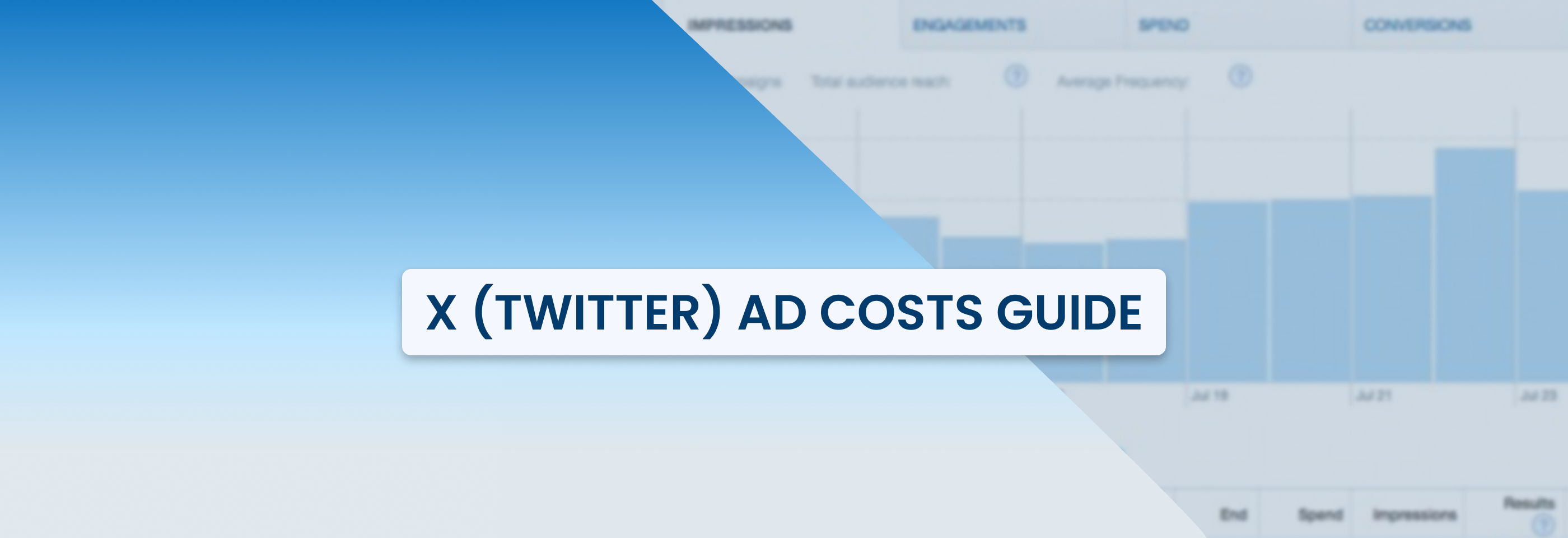The Ultimate Playbook To Successul Instagram Ads That Convert
2024-09-19
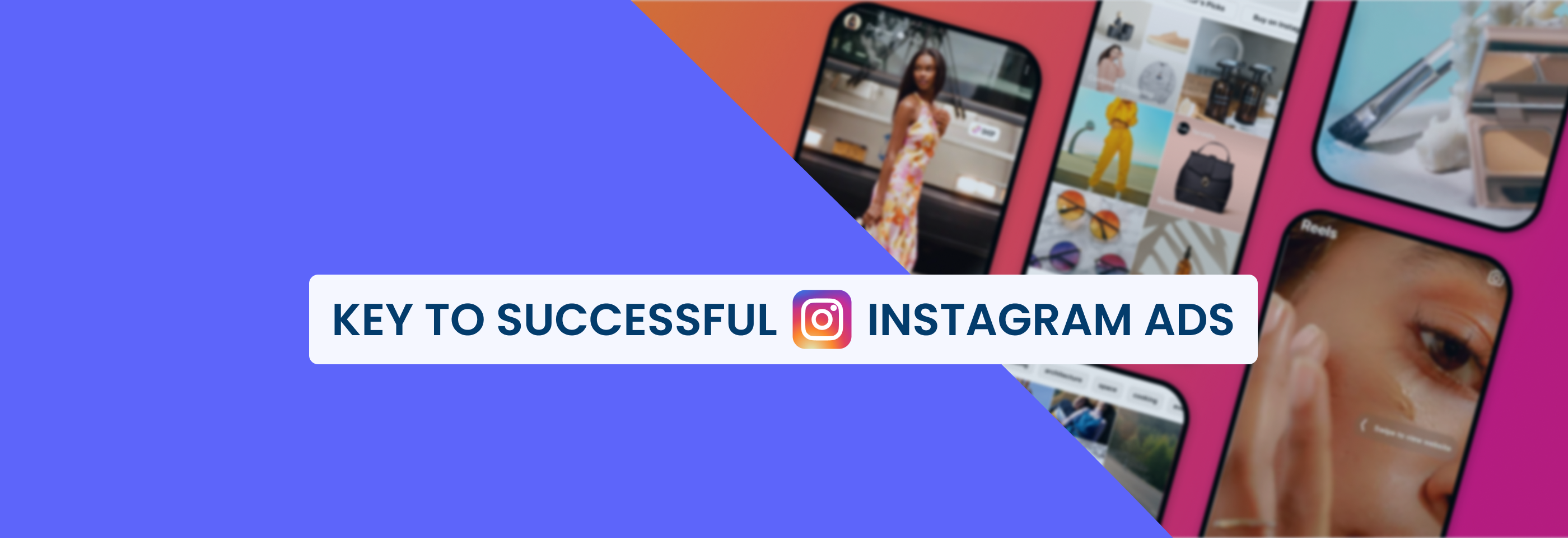
It’s a fact that Instagram ads are effective for different kinds of businesses, but with so much competition out there, it can be hard to stand out and achieve significant results.
In this guide, we'll explore the main Instagram ad formats and their specs, and share some simple strategies to create Instagram ads that get attention, spark engagement, and drive conversions.
If you’re ready to elevate your Instagram advertising strategy, let’s get started with the most important aspect of running truly effective ads.
Know your audience and goals
Understanding what your ideal customers like and what you want to achieve with your ads can make all the difference in terms of ad performance.
Here are the steps to follow:
Create your Buyer Personas
To make your Instagram ads hit the mark, you need to know your audience like the back of your hand.
Start by creating your ideal buyer personas, or detailed profiles of hypothetical Instagram users who might be interested in your product or service. This includes details like their age, interests, the type of content they enjoy, etc. Knowing these details helps you create ads that speak directly to them, use appealing visuals, and choose the best ad placements.
Here’s how to do this:
- Check your current followers: see who follows you on Instagram and what they like. Look at the posts they engage with most to get clues about your ideal customers.
- Analyze your best customers: consider users who have already bought from you and love your products. What do they have in common? What problems are they solving with your products? You can find this information through website analytics or customer surveys.
- Identify patterns: look for common traits among your audience. For example, you might discover that many followers share a similar age or interests.
- Create detailed personas: use this information to create profiles of your ideal customers. Include the most relevant details and focus on the bigger picture.
- Test and refine your personas: use them to create Instagram ads and check their performance. Adjust based on results and feedback to better fit your audience's preferences.
Remember: these personas are only a rough hypothesis of what your ideal customer is, so test and refine them to get more accurate data. You can also learn more about choosing the right audience for your Instagram ads with Meta targeting options in one of our guides.
Match your ad objective to your business goals
Let’s discuss how to align your Instagram ads with your goals, or your campaign objective. Here are the main objectives you can pick from:
- Awareness: this is great if you want to get noticed, especially if you're new to Instagram ads or looking to find new customers. You can use Feed, Stories, Explore, and Reels ads to reach a wider audience and make a strong impression.
- Traffic: use this if you want to drive more visitors to your website or profile. Feed, Stories, Explore, Reels, and Shopping ads are great for directing users to where you want them.
- Engagement: choose this if you want to increase likes, comments, and shares. Feed, Stories, Explore, and Reels ads are perfect for encouraging interactions and getting your audience involved.
- Leads: use this if you want to collect information about your audience. Feed, Stories, Explore, Reels, and Shopping ads are good for gathering leads and building your contact list.
- App Promotion: choose this to encourage more downloads or use of your app. Feed, Stories, Explore, Reels, and Search Results ads will help you reach users who are likely to engage with your app.
- Sales: use this to drive product purchases. Feed, Stories, Explore, Reels, Shopping, and Search Results ads are best for encouraging users to buy.
Picking the right objective helps you get better results by clarifying your goals, tactics, and metrics to track. For more details on each option, check out our guide to Facebook campaign objectives, which also apply to Instagram.
Now, let’s discuss the key tips for creating Instagram ads that get noticed and drive results.
Create effective Instagram Ads
The recipe for successful Instagram ads has several ingredients: ad format, ad placement, and creatives. To make your Instagram ads work, you need to pick your ingredients mindfully – the right combination will help you achieve what you want.
Here’s how to create a perfect combo:
1. Choose the right ad format and placement
The type of ads you choose to create can make a big difference in the results you get. Each type has its own perks and works best for different goals:
1. Image ads
Image ads are straightforward and easy to set up. You use a single image to showcase your product or message, which makes image ads great for a quick and clear promotion.
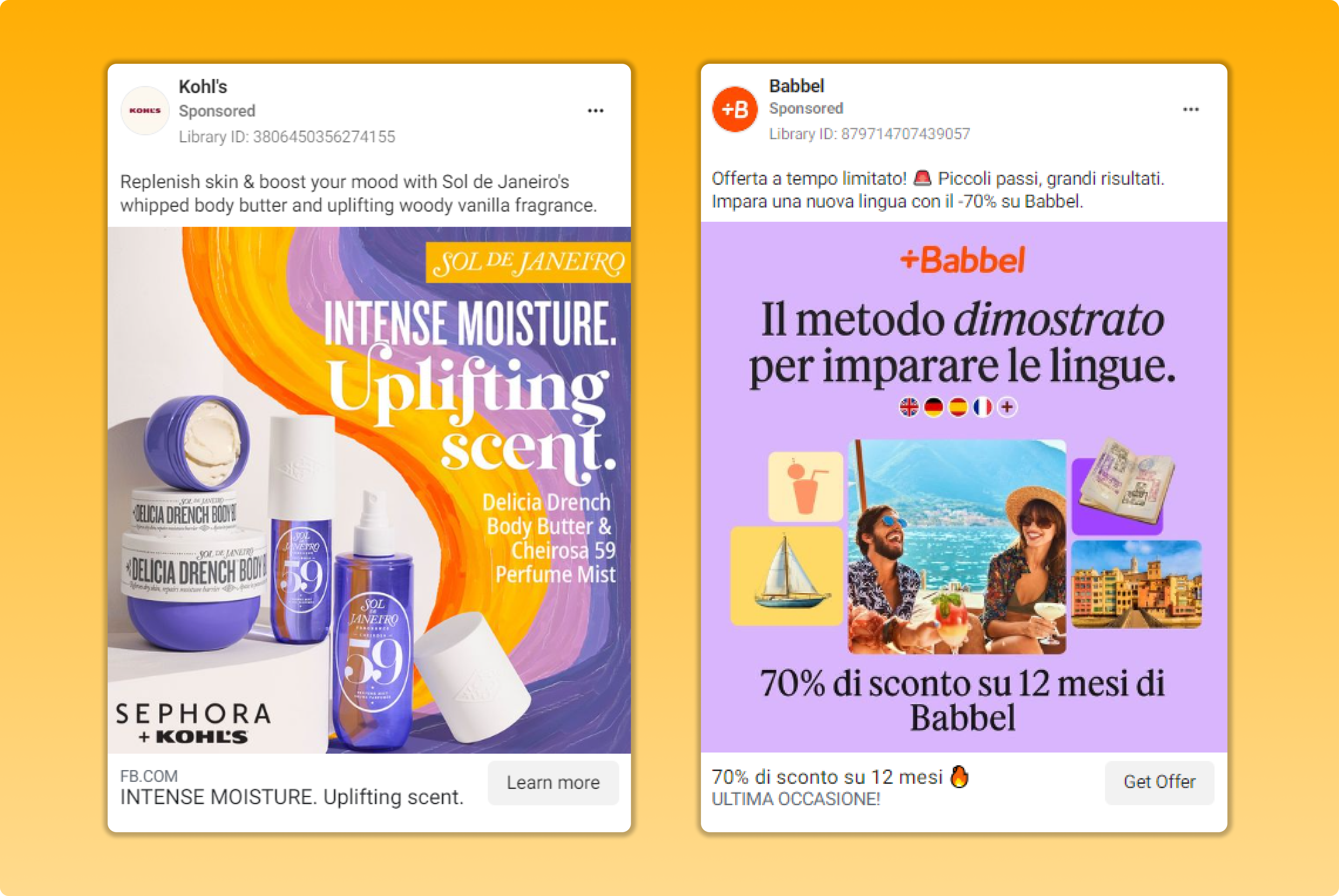
- Best for: highlighting one product or simple messages.
- Design specs: Portrait (1080 x 1350 pixels, 4:5 aspect ratio), Square (1080 x 1080 pixels, 1:1 aspect ratio), Landscape (1080 x 566 pixels, 16:9 aspect ratio).
2. Video ads
Video ads let you tell a story with moving visuals and sound: they’re perfect if you want to dive into product details or create a dynamic experience.
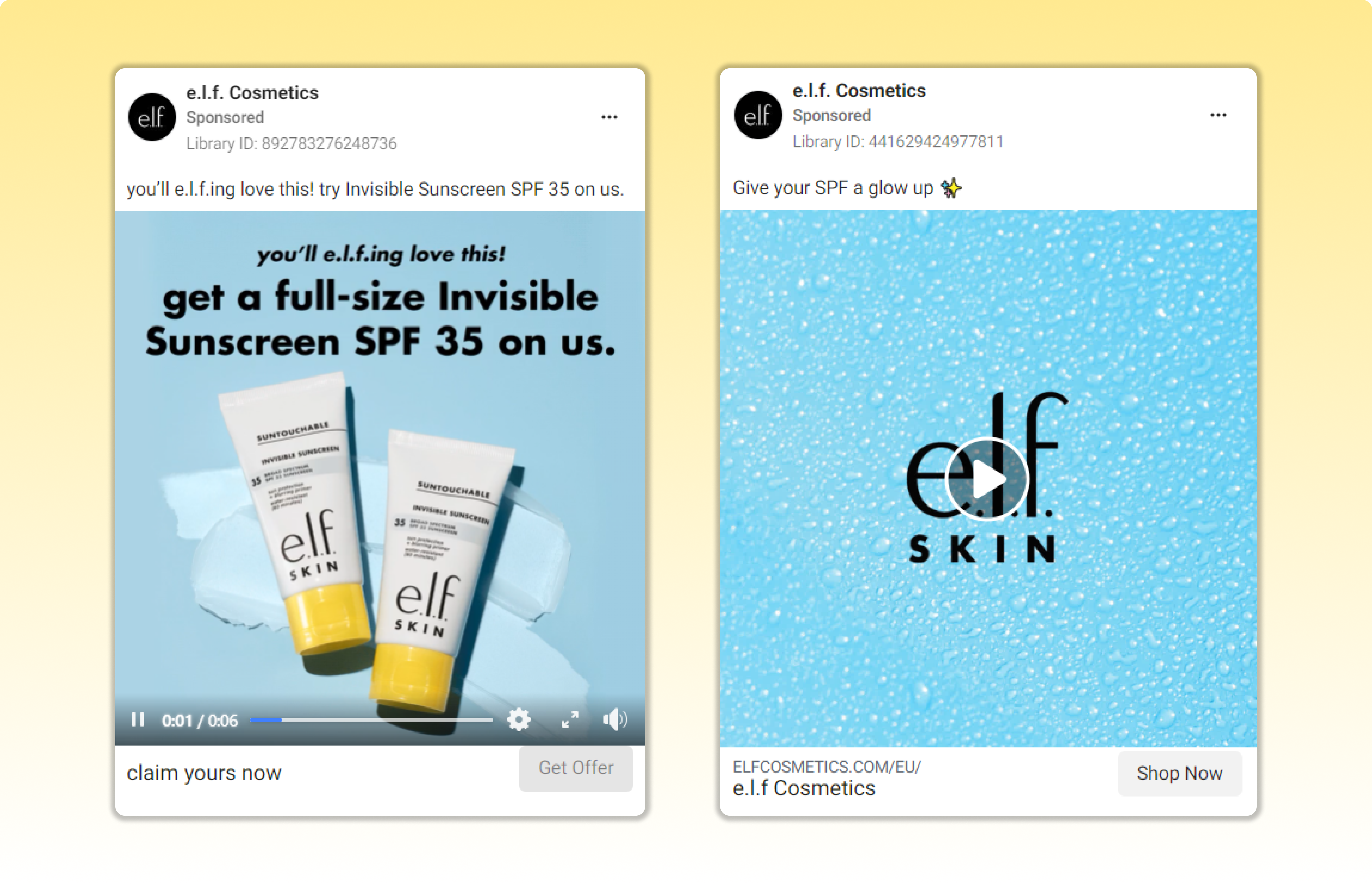
- Best for: engaging storytelling and detailed product demonstrations.
- Design specs: Portrait (1080 x 1350 pixels, 1:1 aspect ratio), Square (1080 x 1080 pixels, 1:1 aspect ratio), Landscape (1080 x 607 pixels, 1.9:1 or 16:9 aspect ratio).
- Video length: up to 60 seconds.
3. Carousel ads
Carousel ads let you show multiple images or videos in one ad. Users can swipe through them, which is great for displaying different products or features.
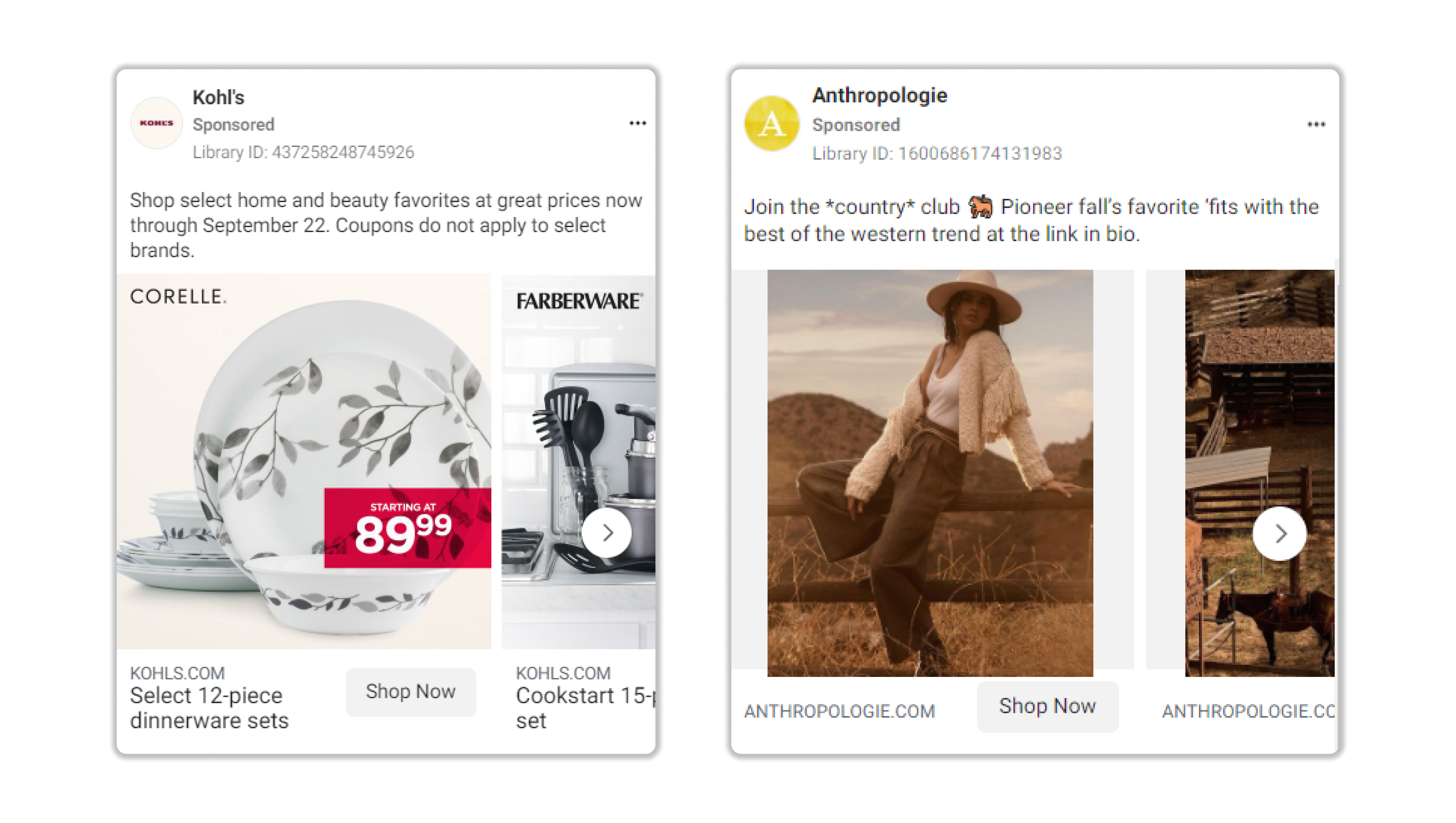
- Best for: showcasing a variety of products or telling a story in steps.
- Design specs: Square (1080 x 1080 pixels, 1:1 aspect ratio), Landscape (1080 x 566 pixels, 1.9:1 aspect ratio for videos), Portrait (1080 x 1350 pixels, 4:5 aspect ratio).
- Number of cards: up to 10 cards.
4. Story ads
Stories ads are full-screen and appear between users' stories. They’re excellent for grabbing attention with quick, immersive content.
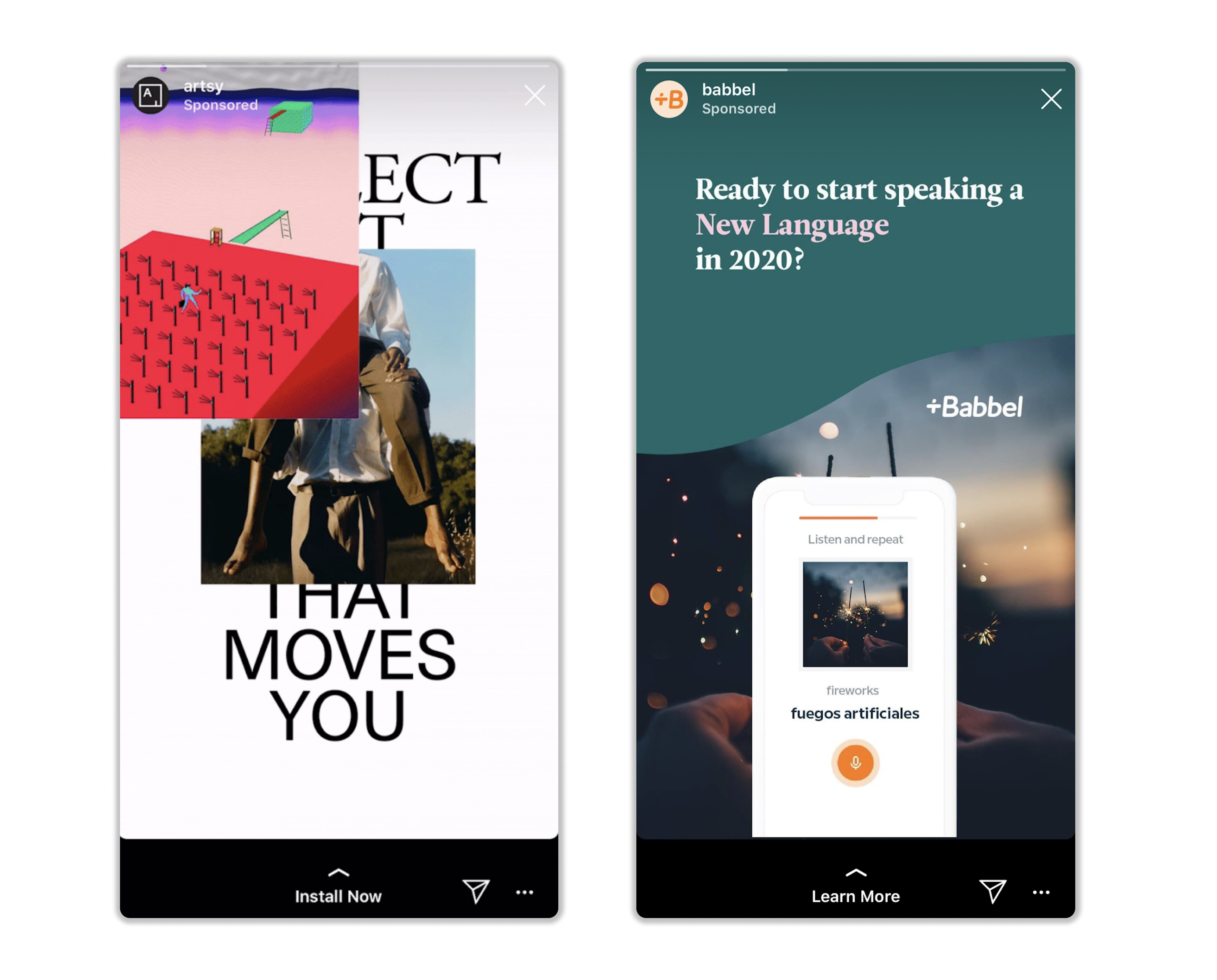
- Best for: quick, eye-catching promotions or engaging content.
- Design specs: 1080 x 1920 pixels, 9:16 aspect ratio.
- Video length: up to 15 seconds.
5. Reels ads
Reels ads are short, engaging videos that fit into the Reels feed. They’re perfect for jumping on trends or creating viral content.
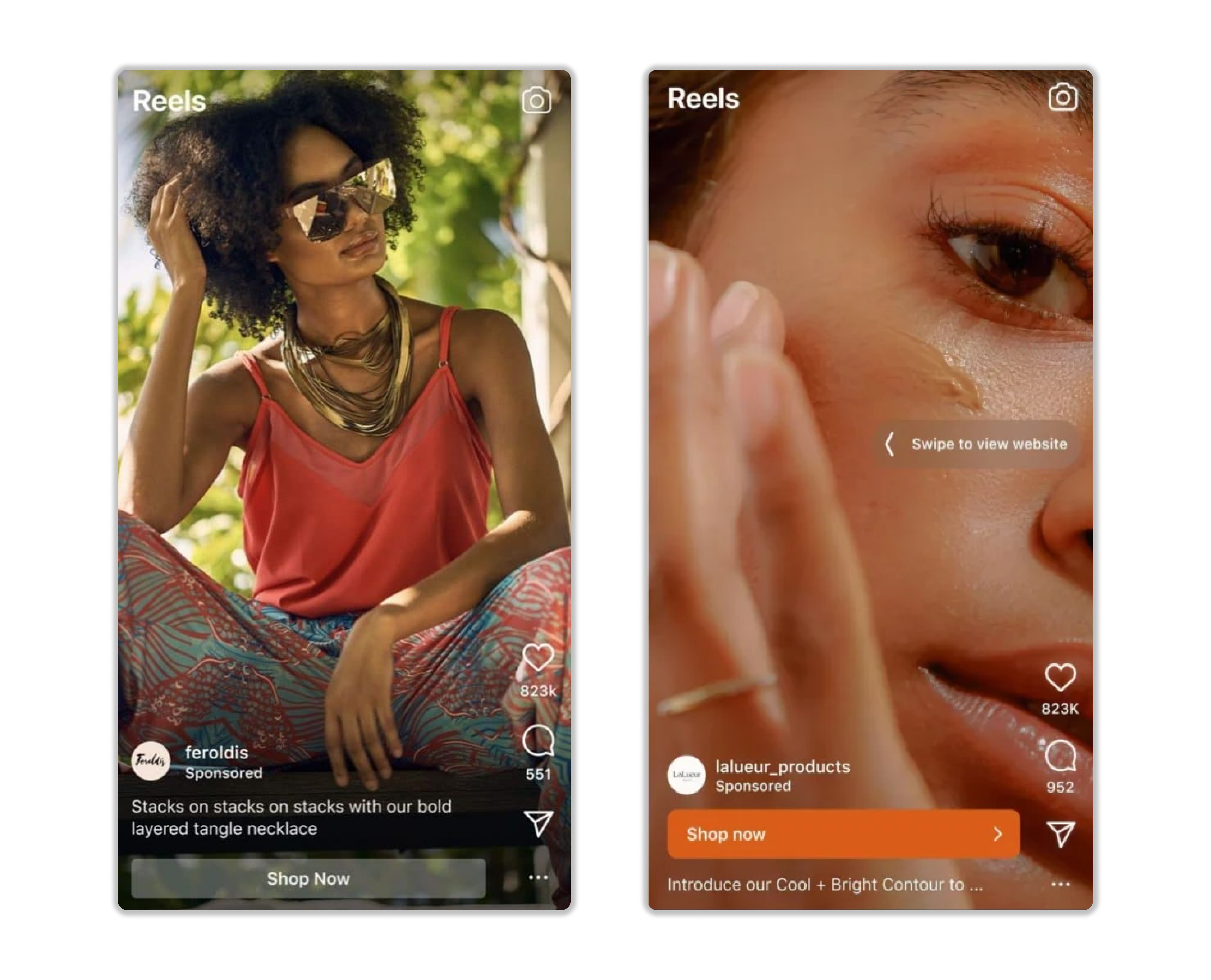
- Best for: creative, entertaining content that blends with user-generated Reels.
- Design specs: 1080 x 1920 pixels, 9:16 aspect ratio.
- Video length: up to 90 seconds.
6. Collection ads
Collection ads show multiple products in a grid format. They create an immersive shopping experience right on Instagram.
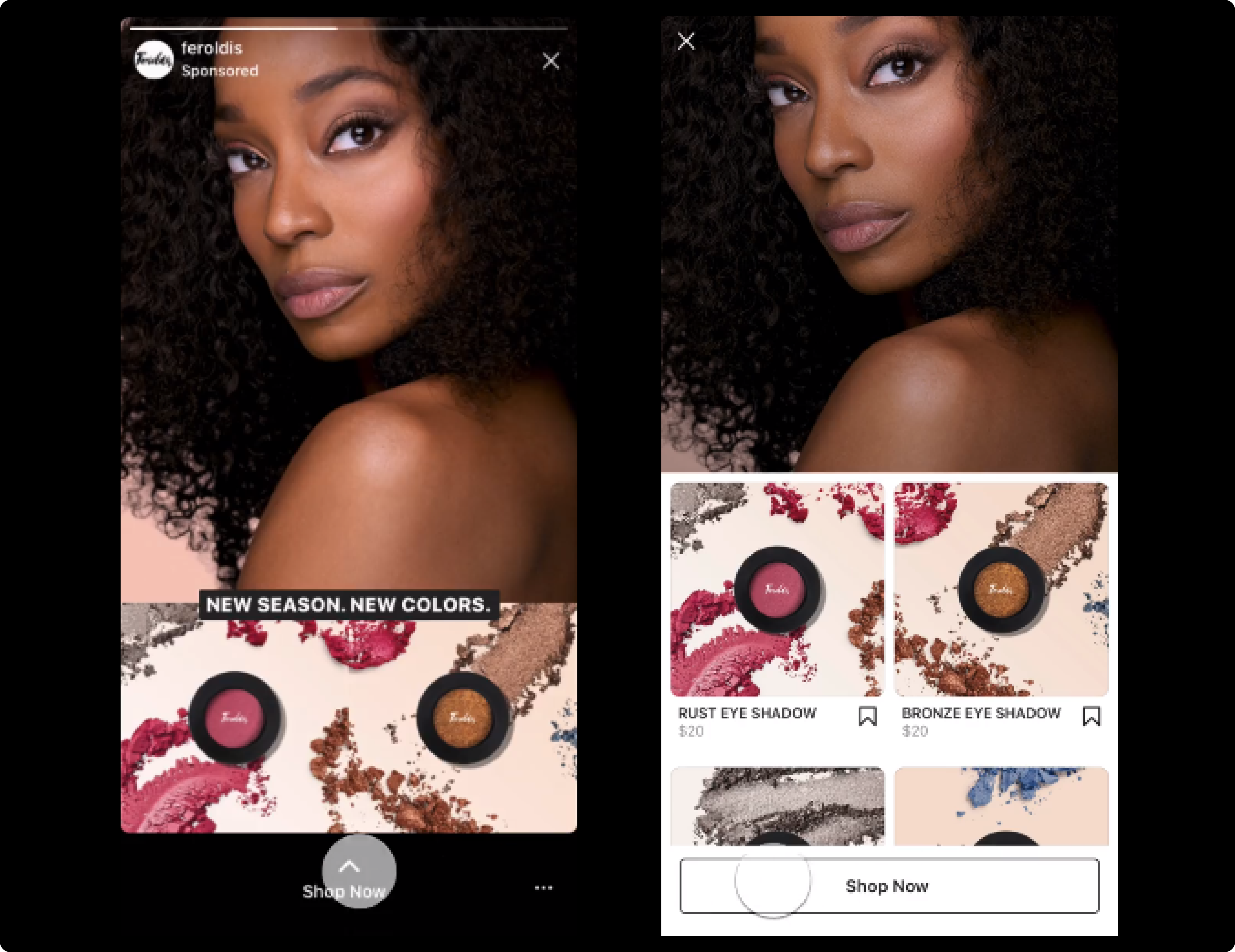
- Best for: Highlighting multiple products and driving in-app purchases.
- Design specs: cover image/video of at least 1080 x 1080 pixels (1.91:1 to 1:1 aspect ratio), product images of 500 x 500 pixels (recommended).
7. Explore ads
Explore ads appear in the Explore tab, where users discover new content. They’re great for reaching users who are actively looking for new brands.
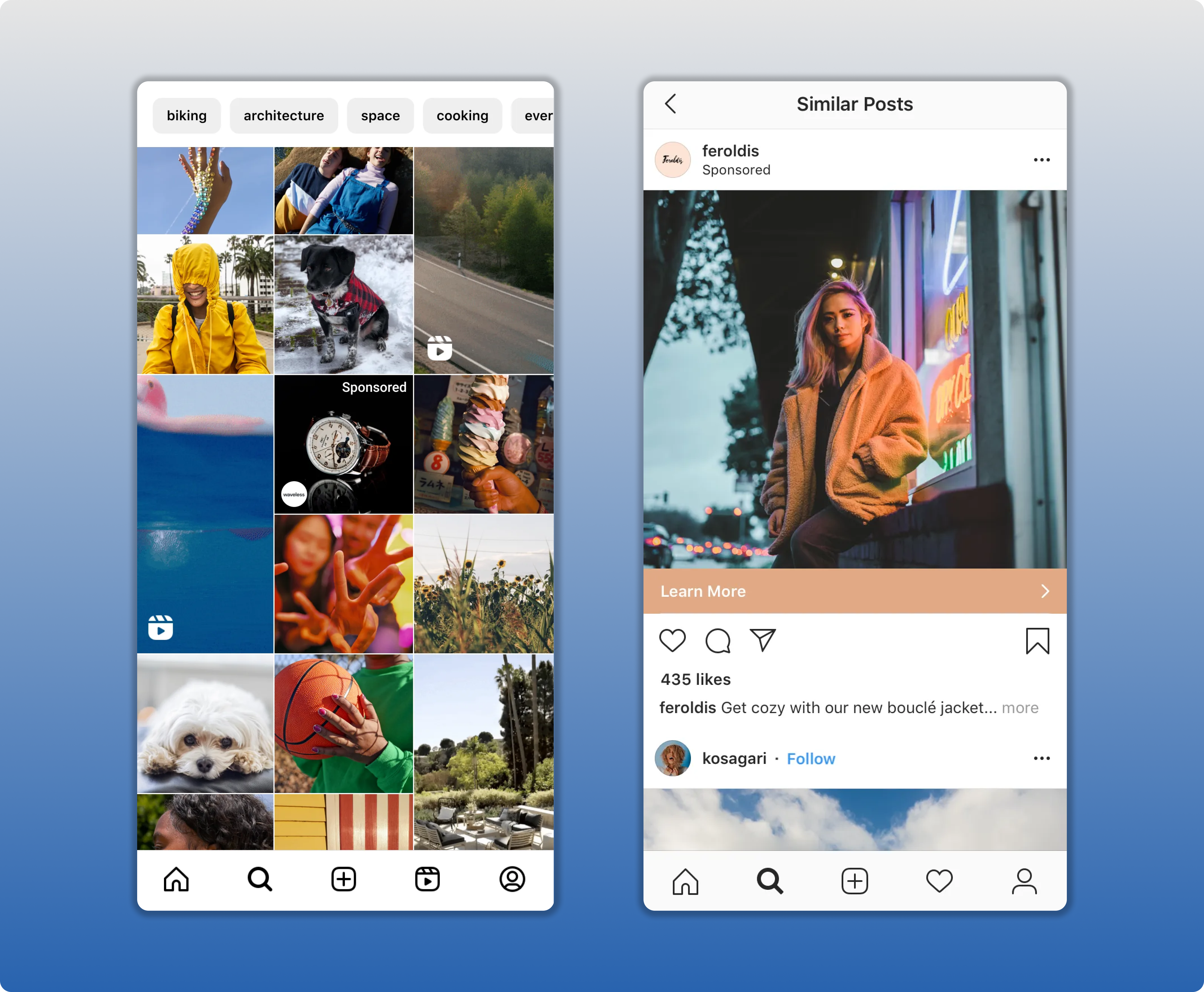
- Best for: Increasing brand visibility among users exploring new content.
- Design specs: same as Image, Video, and Carousel ads.
8. Shopping ads
Shopping ads let you tag products directly in your images or videos, making it easy for users to buy without leaving Instagram.
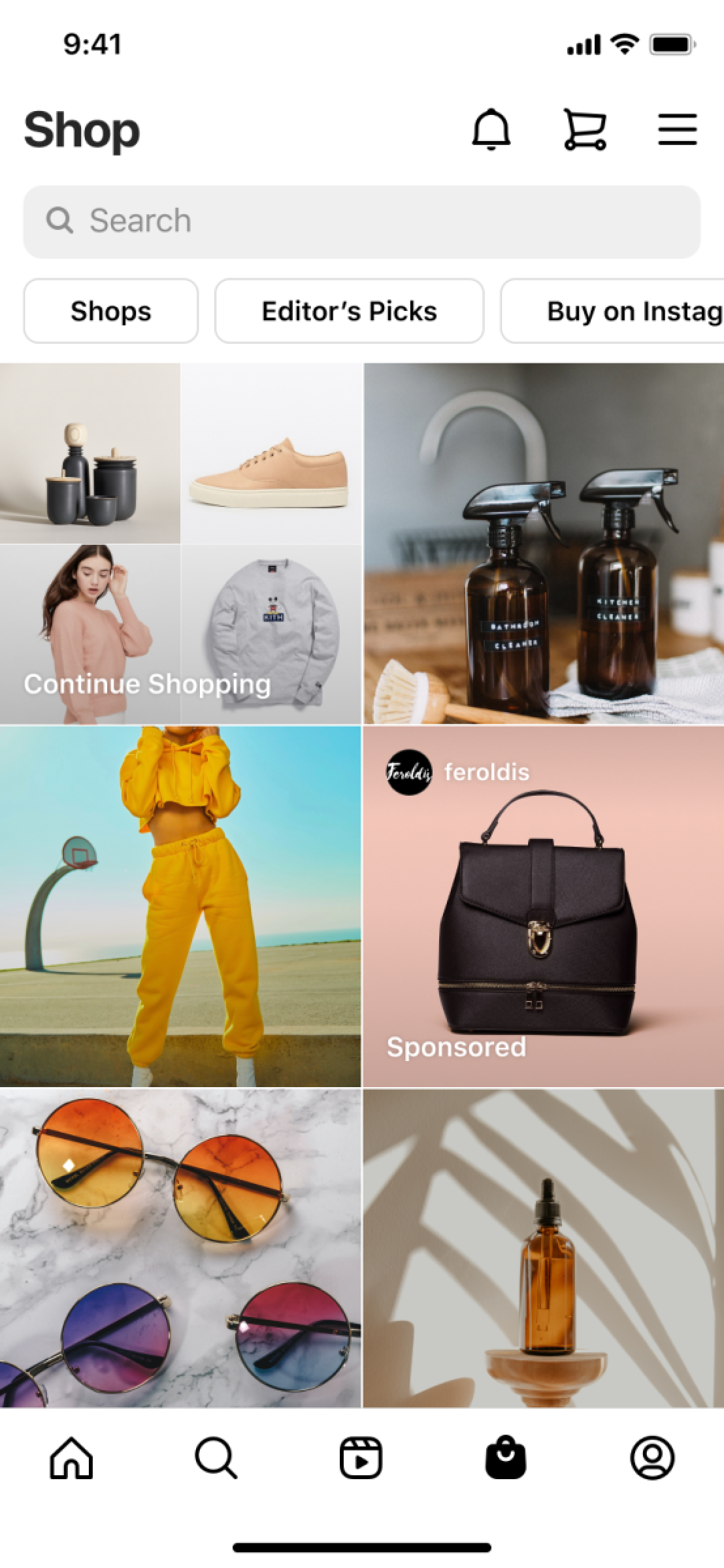
- Best for: E-commerce businesses looking to drive direct sales from Instagram.
- Design specs: same as Image, Video, and Carousel ads; have product tags.
If you’re wondering which Instagram ad format will be the most effective for you out of all them, the answer is simple: it depends on what you want to achieve.
For brand awareness campaigns, go with Image or Stories ads. They're quick and visually engaging, making it easy to introduce your brand to new people.
If you’re trying to show multiple products, Carousel or Collection ads work well. Carousel ads let people swipe through different images or videos, and Collection ads display several products, allowing users to browse without leaving Instagram.
To drive traffic or boost sales, Shopping and Collection ads are your go-to. They let users click directly on products, making it easy for them to shop right from the ad.
Finally, you can use Reels and Explore ads to engage new audiences and get more eyes on your content. Reels ads take advantage of popular short videos, while Explore ads reach people looking for new content.
With these ad formats in mind, you can choose the one that best fits your goals and start creating impactful Instagram ads.
2. Create engaging ads
If you want to catch people’s attention and encourage them to interact with you, your ads have to be engaging. They should make people stop scrolling and see what you have to say.
These tactics will help you achieve this:
1. Match ad creatives to your goals
Your ad creatives should directly reflect what you're trying to achieve: more exposure, followers, website or Instagram shop visitors, or conversions? Each campaign goal has its own choices of visuals and copies, so get clear on the result you want to see and pick the right creative to achieve it.
Here are some ideas to try:
- For sales: show your product in action or offer a special discount. If you’re promoting a store, try using a carousel ad to show different products, and add a “Shop Now” button to encourage purchases.
- For brand awareness: use high-quality images with your brand colors and logo. Make sure the visuals stand out and grab attention, like high-quality lifestyle photos that reflect your brand’s style.
- For event promotion: if you're advertising an event, show what people can expect, like highlights from past events or teaser clips. You can also use countdown stickers to build excitement.
- For more followers: share a video that introduces your team or shows behind-the-scenes content. People tend to follow brands they feel connected to, so keep it casual and authentic.
- For lead generation: show an offer, like a free guide or coupon, with a clear image and a strong call-to-action button, like “Sign Up Now” to get people interested and engaged.
In short, the more your ad creatives suit your goal and the action you want people to take, the more likely you’ll achieve the desired outcome.
2. Grab attention right away
People scroll fast on Instagram, so your ad needs to stop them in their tracks. Unlike regular posts, which might tell a longer story, ads should hook viewers immediately – you only have a few seconds to do it.
First of all, cover your bases: use high-quality images or videos. This is necessary for both Instagram ads and regular posts, but that’s not all: even the most beautiful photo won’t get enough attention if it doesn’t follow the basic patterns of human perception.
Contrasting colors or patterns can make your ads stand out in a sea of other content and gain more traction. For example, you can pick a palette of 3-5 colors and use it in your ad to accentuate or emphasize certain elements: product visuals, offer details, time limitations, and so on.
Using quick-moving visuals or creating an intrigue with your images can help you make people pause and look at your ad for more than a second. Don’t be afraid to be more creative with your ads and try unorthodox and original approaches in your ad creation process.
Always test different types of visuals (product shots, lifestyle images, unique graphics), colors, patterns, etc. to see what works for your audience. Also, avoid using visuals that feel generic: there are many AI tools for generating ad creatives out there, but you should use them mindfully. Try to create original content that shows off your products or brand personality in a unique way.
Want to see how competitors are using Instagram ads? Our guide to Meta Ad Library can help you start to research successful campaigns and improve your strategy.
3. Tell a story
Instagram is all about telling and sharing stories about people’s lives and experiences. Businesses can tell stories too: your customers are people, your employees are people, and ultimately, everything you do is by and for people.
If you want to use storytelling in your Instagram ads, don’t just show off your product: show it in action, tell a story about how it’s used, or connect it to a larger narrative.
For example, you can create a sequence of ads that follow a story arc, like a customer’s journey or a day in the life using your product:
- Showing your audience a character they can relate to helps build emotional connection. You can even show a real customer in your ads to make it more personal.
- Showing how your product solves problems or transforms someone’s life helps you get your value proposition across. Instead of vague mentions of benefits in your ad copy, you clearly show the purpose of your products.
Carousels, videos ads, and story ads are the best for storytelling. You can use them for building narratives of different complexity levels: showing what a typical customer journey looks like, presenting before-and-after transformations, telling your brand’s story, and so on.
Don’t forget to use captions: they help you further highlight the story and guide users to feel connected to the narrative or character.
4. Keep the message clear and simple
In your regular Instagram posts, it might be enough to just casually encourage people to engage. But Instagram ads are a different story: your message needs to be clear and to the point.
Here’s what you can do to achieve this:
- Avoid long explanations or cluttered designs: focus on a single idea or a goal you’re trying to achieve. Use short, impactful text with no more than 125 characters to deliver your message and avoid using people’s attention.
- Pick a CTA that is simple, easy to understand, and matches both your goal and the type of audience you’re targeting (e.g. a cold or a warm one). Place your CTA in both the caption and the ad itself to make it more visible.
- Avoid overloading your visuals with text: if you must use text, make sure it’s bold and easy to read. You can use contrasting colors or interesting fonts to accentuate the text.
A clear, catchy, and easy-to-understand ad’s message or caption gets your point across and simplifies the decision process for your audience.
5. Use ad formats that match your goals and audience
Each Instagram ad format has its own time and place, but some formats tend to perform better than others for certain goals.
For example, Reels are great for capturing attention – they are designed to be quick, fun, and engaging. If your brand can jump on a popular trend, Reels can help you connect with your audience in a more playful and authentic way. You can show your audience that you’re in tune with what’s happening on Instagram and willing to create fresh and timely content.
Also, Reels can feel like native content, which makes it more likely for people to watch your ad till the end without scrolling past it. To make your Reels stand out, use trending music or sounds, and include interactive elements like polls or questions.
Another great but underestimated format is Explore ads: they help you reach users who are actively searching for new content in your niche. This is an excellent (and also easy) opportunity to make your business and products more visible. Again, your ads should grab people’s attention in a few seconds – that’s the only way to make them noticeable in the Explore tab.
As we’ve said earlier, Carousel ads are perfect for storytelling and showing different products or product features. For example, if you’re promoting a new product line, use a carousel to highlight each item’s unique features or show the product in various scenarios.
If you’re looking to show the variety of products, there are also Collection ads: they let users browse your products directly within the ad. This is ideal for driving sales and making it easy for users to shop without leaving Instagram.
6. Add interactive elements
Instagram Stories is another effective ad format, and the best thing about it is that it allows you to add interactive features like polls, questions, and sliders.
These little details can encourage users to interact directly with your content, which increases engagement and makes your ad more memorable. It also helps you discover your audience’s preferences and get feedback on important issues.
For example, if you’re promoting a new product, you can create a Story ad with a poll to ask users which color or feature they like best. Or, you can use Instagram’s slider tool to ask your audience for their opinion on your upcoming product launch, like “How excited are you for this?”.
7. Add music for more impact
Adding music to your Instagram ads can help set the mood and increase engagement. An Instagram Reel or a video without music is like milk without cookies: well, it’s certainly an option, but why choose it when it can be a lot better?
Music grabs attention, evokes emotions, and helps your ads stand out. It can be a trending song, catchy beat, or relaxing background music – whatever you choose, make sure it brings life to your ad.
For example, you can add a trending track to your Reels ad to try and get some virality intrinsic to this format. The easiest way to find licensed background music for your ads is using Instagram’s music library: you can access via the music sticker in Stories or the audio icon in the Reels camera.
Different types of music bring about different types of engagement and suit different kinds of ads.
For example, energetic and upbeat music can add vibrancy to your ads. This type of music works well for product demos, event promotions, or anything that needs a burst of enthusiasm. Trending songs help you tap into current trends and make your ad resonate with a broader audience. Relaxing music is best for ads promoting wellness products or services because it creates a relaxed atmosphere and conveys a sense of calm. Using festive music in your ads is the easiest way to evoke a sense of celebration during holiday season.
8. Optimize Instagram ads for maximum ROI
With Instagram advertising costs adding up quickly, it’s important to know what to expect and use smart strategies to get the most value out of your budget. If you want to make sure that every dollar you spend on your Instagram ads delivers, you have to optimize them.
You can start by checking out this guide on Instagram ad costs for detailed insights, and then follow these tips to maximize your ROI:
Keep an eye on ad costs and performance
If you want to know how your ads are doing, regularly track key metrics like cost per click (CPC), cost per mille (CPM), and cost per action (CPA). These metrics provide valuable insights into how efficiently your budget is being spent.
CPC tells you how much you’re paying each time someone clicks on your ad. A low CPC means you’re getting clicks at a cheaper rate, which is great if you’re focused on driving traffic to your website or landing page.
A high CPC could indicate that your ad isn’t engaging enough or that your targeting needs improvement. To lower your CPC, consider refining your audience, improving your ad copy or visuals, and testing different ad formats.
CPM is the cost of showing your ad 1,000 times (impressions). A low CPM is ideal for brand awareness campaigns since it means you’re getting a lot of visibility for less money.
A high CPM might mean your ads aren’t competitive in the current auction, or your targeting is too broad or narrow. To bring your CPM down, try adjusting your targeting parameters, experimenting with placements, or tweaking your bid strategy.
CPA reflects how much you’re paying when someone takes a specific action, like making a purchase or signing up for your service. A low CPA indicates that your ads are driving conversions efficiently, while a high CPA suggests that you’re paying too much for each desired action.
If your CPA is high, you might need to optimize your landing page, improve your call to action (CTA), or refine your audience targeting to reach more relevant users.
Instagram’s analytics give you a clear view of how your ads are performing and where your money is going. Monitoring these costs and performance indicators helps you tweak your strategies to boost ROI and ensure your budget is being used wisely.
Automate for efficiency
Ad automation can become your best friend if you’re looking for an easier way to optimize your ad performance.
For example, if you’re just starting with Instagram ads or don’t have a lot of data, automatic bidding can be a lifesaver. This feature lets Instagram set the best bid amount for your campaign based on current conditions and competition. It helps you avoid overspending and makes sure you’re only paying what you need to achieve your goals.
As you gather more data, you can refine your bidding strategy, but automatic bidding can help you keep your costs under control and maximize ROI from the start.
Another way to manage your Instagram ads and ad budgets more efficiently is through automated rules: they let you automatically adjust your bids, pause ads that aren’t doing well, and move your budget around based on real-time performance data.
 This rule will automatically pause your Instagram ad campaign if it has a low CTR and a high ad spend.
This rule will automatically pause your Instagram ad campaign if it has a low CTR and a high ad spend.
You can easily create these rules with ConvertBomb and start automating your Instagram ad management in just a few steps.
Recap
So, what’s the secret of successful Instagram ads? It’s pretty simple and lies in these three things:
- Understanding your audience and goals,
- Making your ads engaging,
- Optimizing your ads for better results.
If you follow the tips in this article, you’ll be set to create and run Instagram ads that really work and deliver the results you want to see.
No matter the size of your business, these strategies can help you get more from your ads on Instagram. For additional insights on how to grow your business on Instagram, check out our previous article with top Instagram marketing tactics.

